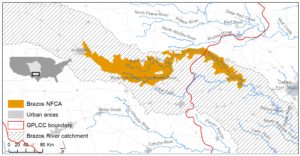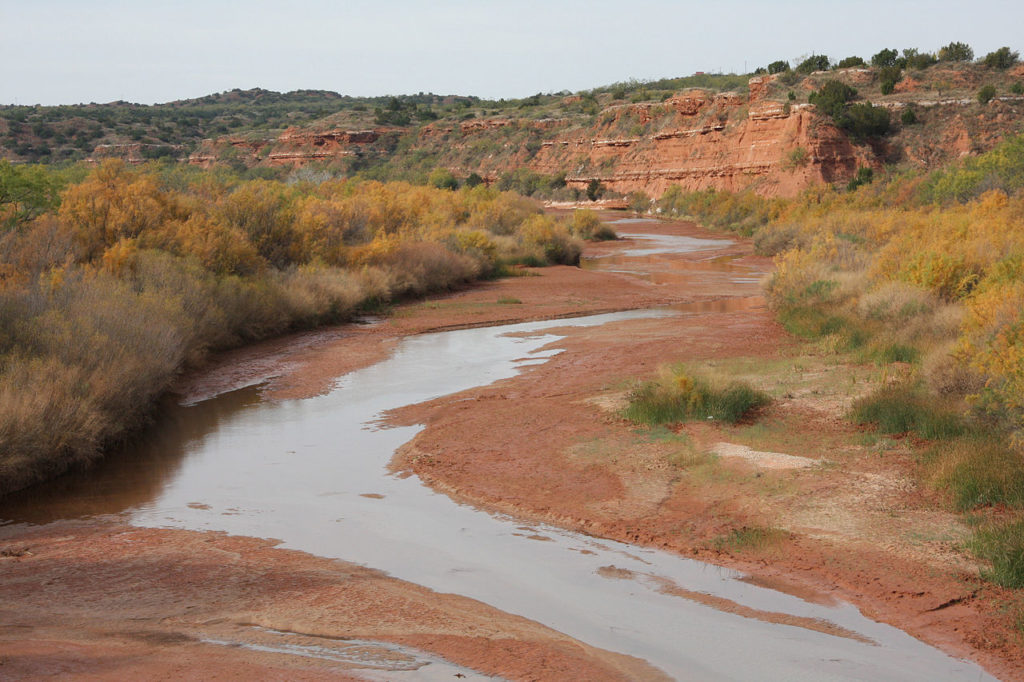Upper Brazos NFCA Profile
...wide and shallow and characterized by sandy substrates
Double Mountain Fork Brazos River north of Rotan, Texas.
Conservation Profile
Ecoregion
Edwards Plateau.
Biotic Province
Kansan
Stresses
Primary – flow regime alteration, habitat loss and habitat fragmentation. Secondary – pollution, golden alga blooms, legally permitted commercial bait fish harvesting (the shiners), hybridization with introduced non-natives (the pupfish). “Possible new impoundments include the 2012 State Water Plan’s proposed Post Reservoir in Garza County, the Double Mountain Fork Reservoir (East and West) in Stonewall County, and the South Bend Reservoir in Young County” (FWS, 2014)
Partners
Brazos Water Planning Group, Brazos River Authority, TCEQ, TPWD, Texas Environmental Flows Program, Dow Chemical, Texas Farm Bureau
Fishes of concern
American Eel (Anguilla rostrata)
Plains Minnow (Hybognathus placitus)
Shoal Chub (Macrhybopsis hyostoma)
Silver Chub (Macrhybopsis storeriana)
Smalleye Shiner (Notropis buccula, federally endangered)
Sharpnose Shiner (Notropis oxyrhynchus, federally endangered)
Chub Shiner (Notropis potteri)
Silverband Shiner (Notropis shumardi)
Red River Pupfish (Cyprinodon rubrofluviatilis)
The Brazos River is one of the longest rivers in Texas, originating in eastern New Mexico and extending southeasterly to the Gulf of Mexico in Brazoria County. Its enormous basin “covers some 42,000 square miles, about one-sixth of the area of the state” (TX Hist Assoc). Salt Fork and Double Mountain Fork, two tributaries that rise on the high plains of the Llano Estacado, converge in Stonewall County to form the mainstem of the Upper Brazos River. The Brazos NFCA includes lower portions of the two forks, and the mainstem down to Possum Kingdom Reservoir (TX Hist Assoc, FWS).

The upper Brazos River channel is wide and shallow and characterized by sandy substrates. The basin topography limits the movement of runoff when rain does fall in the arid climate of the high plains. A considerable portion of flow to the headwaters and upper basin historically sprang from the Ogallala Aquifer; however, by 1975 these springs were nearly dry (FWS citing Brune’s S of TX, I heart Brune). Although storms may occasionally flood the basin, its upper segments now have such low flows that the river dries to a series of isolated pools in summer (FWS).
 The upper Brazos River and its inhabitants have been severely impacted by flow regime alteration and riverine habitat fragmentation. Severe drought, overpumping of groundwater, and encroachment by invasive saltcedar have altered the natural stream flow. In addition to altering flow and sediment load, impoundments fragment the river, restricting fish migration, notably that of the federally listed sharpnose and smalleye shiners (FWS).
The upper Brazos River and its inhabitants have been severely impacted by flow regime alteration and riverine habitat fragmentation. Severe drought, overpumping of groundwater, and encroachment by invasive saltcedar have altered the natural stream flow. In addition to altering flow and sediment load, impoundments fragment the river, restricting fish migration, notably that of the federally listed sharpnose and smalleye shiners (FWS).

Several reservoir impoundments exist on the Brazos for flood control, recreation, irrigation, electricity, industry, and municipal use. The Brazos River Authority is the public agency responsible for the development and conservation of the Brazos River Basin, an area covering around one-sixth the area of the state of Texas (1/6 also in opening paragraph). The Possum Kingdom Reservoir was the first reservoir built by the BRA (Hist assoc). With the reservoir’s construction in 1941, the sharpnose and smalleye shiners and other wildlife lost the ability to seek refuge downstream in times of drought (FWS).
The worst one-year drought on record in Texas occurred in 2011 and dried the upper Brazos River and its forks. In an effort to save sharpnose and smalleye shiners from extinction, State fishery and Texas Tech University biologists collected them from dwindling pools and maintained a captive population for rerelease (TPWD). It’s possible that some fish found refuge downstream in Possum Kingdom Reservoir (FWS). These fish are important not only to the natural heritage of the river, but serve as important prey for game species such as catfish and largemouth bass (TPWD).
Drought is forecast to become more severe and frequent with climate change, further stressing the river’s already diminished flows. The growing Texas population’s demand currently exceeds supply in the Upper Brazos River basin and additional reservoir construction is imminent (FWS). Even with climate forecasts, the state is pursuing damming up more of the river and its tributaries to supply the 5.4 million people projected to be in the Brazos River basin by 2060 (Dallas Morning News). New structures that further fragment the river habitat or withdrawals that reduce its flow increase the likelihood of species extinction (FWS).
…..In 1957, author John Graves set off from Possum Kingdom Lake on a canoe trip to bid farewell to the Brazos River he knew before a series of proposed dam projects downstream. “Goodbye to a River” is an elegy to Texas’ wild and mighty river before it was lost to modernity, to man’s attempts to tame it and control it. Yet the book is also prophetic. Today, the river is in a death grip…” (Dallas Morning News)
